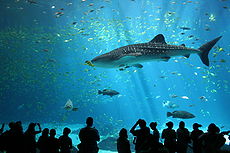
Sharks in captivity
Encyclopedia

Shark
Sharks are a type of fish with a full cartilaginous skeleton and a highly streamlined body. The earliest known sharks date from more than 420 million years ago....
s are kept in captivity
Captivity (animal)
Animals that live under human care are in captivity. Captivity can be used as a generalizing term to describe the keeping of either domesticated animals or wild animals. This may include for example farms, private homes and zoos...
in public aquaria. In home aquaria, size constraints mean that only the smallest sharks are typically viable as pets.
Public aquaria
Until recently only a few benthic species of shark, such as hornsharksHorn shark
The horn shark is a species of bullhead shark, family Heterodontidae. It is endemic to the coastal waters off the western coast of North America, from California to the Gulf of California. Young sharks are segregated spatially from the adults, with the former preferring deeper sandy flats and the...
, leopard sharks, catshark
Catshark
Catsharks are ground sharks of the family Scyliorhinidae, with over 150 known species. While they are generally known as catsharks, many species are commonly called dogfish....
s,and zebra sharks
Zebra shark
The zebra shark is a species of carpet shark and the sole member of the family Stegostomatidae. It is found throughout the tropical Indo-Pacific, frequenting coral reefs and sandy flats to a depth of 62 m...
had survived in aquarium conditions for up to a year or more. This gave rise to the belief that sharks, as well as being difficult to capture and transport, were difficult to care for. A better knowledge of sharks has led to more species (including the large pelagic sharks) being able to be kept for far longer. At the same time, transportation techniques have improved and long distance movement of sharks is becoming easier. One shark that never had been successfully held in captivity for long was the great white. But in September 2004 the Monterey Bay Aquarium successfully kept a young female great white shark for 198 days before releasing her back into the wild.
Home aquaria
Most species of shark are not suitable for domestic aquaria and not every species of shark sold by pet stores make good inhabitants for personal aquaria.Some species of sharks can also be kept well in home saltwater aquaria. Uninformed or unscrupulous dealers sometimes sell juvenile sharks like the nurse sharkNurse shark
The nurse shark, Ginglymostoma cirratum, sometimes referred to as the Nur Shark is a shark in the nurse sharks family, the only member of its genus Ginglymostoma...
, which upon reaching adulthood will have far outgrown typical home aquaria. Public aquaria are generally not interested in accepting donated specimens that have overgrown their housing and some shark owners have been tempted to release
Introduced species
An introduced species — or neozoon, alien, exotic, non-indigenous, or non-native species, or simply an introduction, is a species living outside its indigenous or native distributional range, and has arrived in an ecosystem or plant community by human activity, either deliberate or accidental...
them into the wild.
Housings
However, some species of shark can make prized additions to home aquaria. Species appropriate to home aquaria represent considerable spatial and financial investments as they generally approach adult lengths of 3 feet and can live up to 25 years. Sharks must be housed in aquaria at or exceeding 180 gallons in volume, with more active species requiring more space. Surface area is an even more significant consideration for aquarists than volume as it is the determining factor for the amount of oxygen that ends up being dissolved in the water, and therefore critical to the sharks' respiration. Choice of aquarium substrate is also important because a sharp, rough bed can irritate a shark's soft underbelly, or in severe cases lead to fatal infections. Shark aquaria are generally advised to be decorated "conservatively" in order to leave space for the animal to move more freely during daily activities. A cave, however, is often an appropriate addition for some shy species.Diet and nutrition
Sharks are very frequently overfed by amateur aquarists, which can lead to obesity or unnaturally fast growth rates. Captive sharks are healthiest when fed at levels similar to their food intake in the wild. Usually this amounts to 1-3% of their body weight weekly. However, aquarium conditions and species disposition are considered by conscientious aquarists when feeding captive sharks. Relatively sedentary species, such as wobbegongs can live on feedings occurring once or twice weekly. More active species may require to be fed three or four times per week to maintain satisfactory health. Sharks living in cooler water temperatures have slower metabolisms than sharks in warmer water housings and therefore require less food.The most common staple food provided to captive sharks in home aquaria is frozen fish. The freezing process used to store foods for sharks often results in the food items losing nutrient value. Lost nutrients are replaced by vitamin supplements, which are marketed commercially, sometimes by companies generally associated with more typical pet foods (such as Purina Mills
Purina Mills
Purina Mills, LLC, is the animal feeds unit of Land O’ Lakes. It was previously part of Ralston Purina, but the animal feeds portion was sold in 1986.- History :...
). Uncorrected nutrient deficiencies inherent in the frozen food diet can cause considerable detriment to the health of captive specimens. Conditions such as popeye, ascites, and anemia are known to occur in captive sharks that are deficient in some essential vitamin. Vitamin B deficiency results in a treatable condition where the shark's back arches and it swims in a circular motion.
Feeding sharks frozen non-marine fish can result in deficiencies of omega-3 fatty acids, which can result in "fat infiltration of the liver," which can impede the organ's function seriously enough for major health issues.

